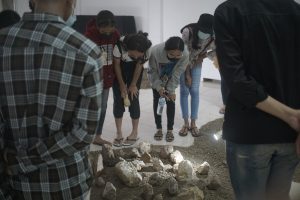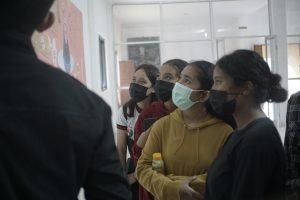R-IBB is a living historical show. Visitors can witness the role of missionaries in spreading the Church’s mission.
The missionaries spread the bible and engaged in an intense dialectic with the local culture. Contact with local culture sparked their curiosity to explore hidden historical sites. They were involved in the excavation process and efforts to collect fossils and historical artifacts of ancient people.
This effort simultaneously shows the church’s inclusiveness towards the existence of local culture. The church views local culture as a treasure that needs to be cared for to form the community’s personal cultural identity. Contact with local culture, no doubt has a positive impact on the dissemination of the church’s mission. The gospel became known. Many people began to recognize the existence of Catholicism. Up to this point, we can say that the R-IBB is a living mirror. R-IBB presents a reflection on life in three different chapters, but at the same time intertwined and related to each other.

Pengunjung mengamati susunan batu di ruang pamer R-IBB (Foto: Bernard Lazar/Dok. Komunitas KAHE)
First, the reflection of the past. The mission of the church in the local community is a total engagement. Missionaries would open up, learn, and live with the community. The intervention of the missionaries had a great impact on the growth of faith, preservation of cultural heritage, improvement of the quality of education, and public health. The character of the mission can be a critique and lesson for today’s missions which tend to be static and instantaneous.
Second, the reflection of the present. Reflection of the past always influences the present model of life. Amid the strengthening of modernism, the church is required to learn from past missionaries. The question is, what is the mission of the church today? Is the church still open to local cultural treasures? To what extent does the church intervene with issues surrounding culture?

Para pengunjung mendapat penjelasan karya di R-IBB (Foto: Bernard Lazar/Dok. Komunitas KAHE)
Third, reflection on life in the future. Reflection of the past and the present have a bias for future life. How to build the church in the future? Starting from the past and present, the church needs to develop a more contextual mission strategy. This contextualization effort can be built with dialogue and cooperation to maintain local traditions so that shared values are formed.
***
Through the whole series of events, the R-IBB exhibition could become an opportunity to increase public knowledge about history, especially to know and learn about the mission model carried out by ancient missionaries. In addition, it is hoped that the community can build an appreciation for local cultural values.
In this regard, cooperation from all parties is needed to revive the spirit of Bikon Blewut. The SVD Ledalero community as the host is required to bear this responsibility. Which could mean working together with the Department of Tourism, the Department of Culture, the Department of Antiquities, and all parties who have a stake in regulating the existence of the museum.
In this way, the Bikon Blewut Museum will become a cultural site that plays a role in disseminating the historical heritage of the past. A beautiful sight to behold and an interesting subject to study.